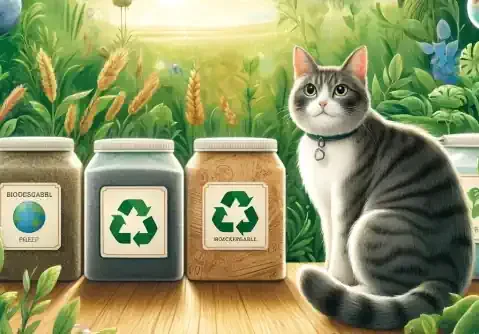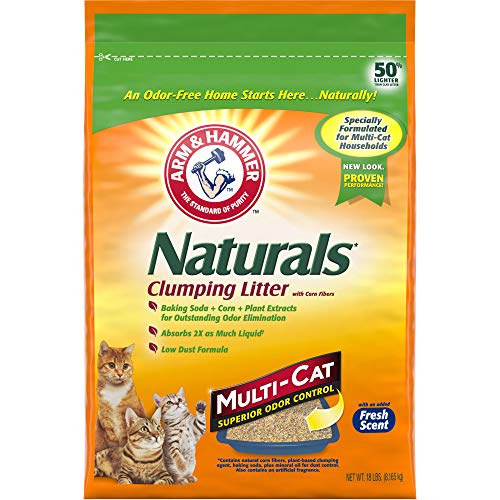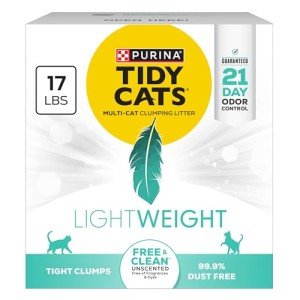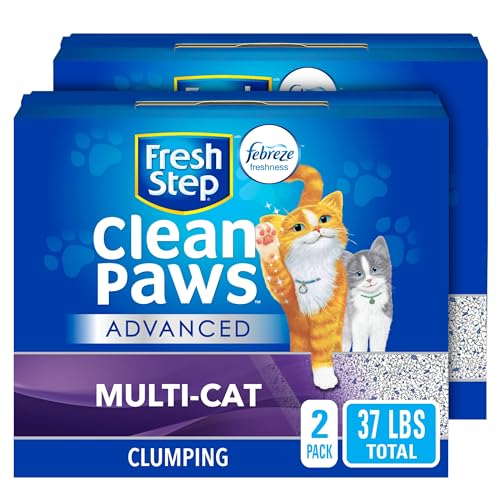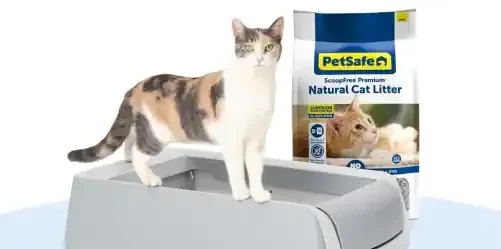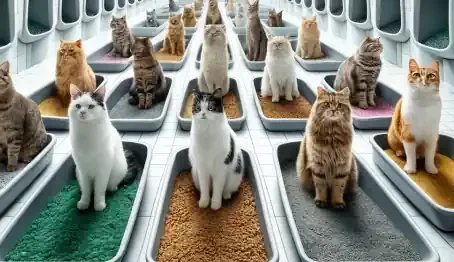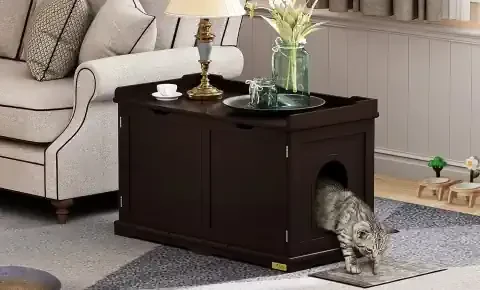Selecting the right cat litter is a crucial decision for any pet owner. Beyond merely providing a place for your feline friend to relieve themselves, the type of litter you choose can significantly impact their comfort, hygiene, and overall well-being. With countless options available on the market, ranging from traditional clay-based litters to eco-friendly alternatives, navigating the world of cat litter can feel overwhelming.
In this comprehensive guide, we aim to demystify the process of selecting the perfect cat litter by providing valuable insights, practical tips, and expert advice. Whether you're a first-time cat owner or a seasoned pet parent looking to upgrade your litter solution, this guide will equip you with the knowledge and tools necessary to make an informed decision that meets both your cat's needs and your lifestyle preferences.
Throughout this guide, we'll delve into various aspects of cat litter selection, including understanding your cat's unique preferences, exploring different types of litter, prioritizing features such as absorbency and odor control, and considering environmental and budget-friendly options. We'll also address special considerations for multi-cat households and offer strategies for transitioning to a new litter seamlessly.
At the heart of our discussion lies a fundamental understanding: that the litter box is more than just a practical necessity—it's a vital aspect of your cat's daily routine and a reflection of their health and happiness. By investing time and effort into selecting the right cat litter and maintaining a clean and inviting litter box environment, you can ensure that your cat receives the care and comfort they deserve while enhancing your bond and enriching your shared experiences together.
Join us as we embark on a journey to discover the perfect cat litter—a journey that promises to not only improve the quality of life for your beloved feline companions but also enhance the joy and fulfillment of pet ownership for you, their dedicated caregiver.
Understanding Your Cat's Needs
Cats, known for their independence and discerning personalities, often have specific preferences when it comes to their litter boxes. Understanding these preferences and needs is crucial for selecting the perfect cat litter. By considering various factors such as age, health conditions, and litter box habits, you can ensure that your choice aligns with your feline companion's requirements for comfort and hygiene.
Importance of Considering Your Cat's Preferences and Habits
Age: Just like humans, cats' needs evolve as they age. Kittens may require softer litter that is gentle on their delicate paws, while older cats might benefit from litter with enhanced odor control to accommodate changes in their digestive systems.
Health Conditions: Cats with certain health conditions, such as arthritis or urinary tract issues, may find certain types of litter more comfortable or preferable. It's essential to consult with your veterinarian to determine if your cat has any specific litter requirements based on their health status.
Litter Box Preferences: Cats can be particular about the type of litter they prefer. Some cats prefer fine-grained litter, while others may favor larger, coarser textures. Observing your cat's behavior in the litter box can provide valuable insights into their preferences, helping you choose a litter that they'll be more likely to use consistently.
Factors to Consider: Age, Health Conditions, Litter Box Preferences, etc.
Age: Consider your cat's age and life stage when selecting litter. Kittens may require low-dust, unscented litter to prevent respiratory issues, while senior cats may benefit from softer, more absorbent options.
Health Conditions: Cats with health issues such as allergies or sensitivities may require hypoallergenic litter options. Additionally, cats prone to urinary tract infections may benefit from litter specifically designed to promote urinary health.
Litter Box Preferences: Pay attention to your cat's litter box habits and preferences. Factors such as texture, scent, and clumping ability can influence whether your cat feels comfortable using the litter box.
Multi-Cat Household Dynamics: If you have multiple cats, consider their individual needs and preferences when selecting litter. Cats in multi-cat households may have different litter box preferences, so providing multiple litter boxes with various litter options can help prevent litter box issues and promote harmony among your feline companions.
Understanding these factors and tailoring your choice of cat litter accordingly can contribute to a positive litter box experience for your cat and help maintain a clean and odor-free environment in your home.
Types of Cat Litter
When it comes to cat litter, the options seem endless, each boasting different features and benefits. Understanding the various types of cat litter available can help you make an informed decision based on your cat's preferences, your budget, and environmental considerations.
Clumping vs. Non-Clumping Litter: Pros and Cons
Clumping Litter: Clumping litter forms solid clumps when it comes into contact with moisture, making it easier to scoop out waste and maintain a clean litter box. This type of litter often provides better odor control and tends to last longer than non-clumping alternatives. However, clumping litter can be more expensive than non-clumping varieties and may pose a risk if ingested by cats, particularly kittens or those prone to gastrointestinal issues.
Non-Clumping Litter: Non-clumping litter absorbs moisture without forming solid clumps, making it a suitable option for cats with sensitive paws or those that dislike the texture of clumping litter. Non-clumping litter is typically more budget-friendly than clumping varieties and poses a lower risk if ingested. However, it may require more frequent complete litter box changes to maintain cleanliness and odor control.
Silica Gel Litter
Description: Silica gel litter is composed of small, granular beads made from silica dioxide. These beads are highly absorbent and effectively lock in moisture and odors.
Benefits: Silica gel litter is known for its superior absorbency and odor control, making it an excellent choice for households with one or more cats. Additionally, silica gel litter produces minimal dust and tends to last longer than traditional clay-based litters.
Considerations: While silica gel litter offers many advantages, some cats may not like the texture of the beads, especially if they have sensitive paws. Additionally, silica gel litter is more expensive than clay-based alternatives, which may be a consideration for budget-conscious cat owners.
Natural and Biodegradable Options
Description: Natural and biodegradable cat litters are made from renewable materials such as wood, paper, corn, wheat, or grass. These litters are often free from synthetic chemicals and fragrances, making them a popular choice for environmentally conscious cat owners.
Benefits: Natural and biodegradable litters are typically more eco-friendly than traditional clay-based litters, as they decompose more easily and are often flushable or compostable. Additionally, these litters may offer superior odor control and clumping ability compared to some clay-based litters.
Considerations: While natural and biodegradable litters offer many benefits, they may be more expensive than traditional clay litters and may not always provide the same level of odor control or clumping performance. Additionally, some cats may be sensitive to certain natural materials, so it's essential to monitor your cat's reaction when transitioning to a new litter.
Absorbency and Odor Control
One of the most critical factors to consider when selecting cat litter is its ability to absorb moisture and control odors effectively. A litter that excels in these areas can help maintain a clean and hygienic litter box environment, contributing to your cat's comfort and overall well-being.
Importance of Absorbency for Moisture Control
Preventing Moisture Build-Up: Cat litter's primary function is to absorb urine and moisture from feces, preventing it from pooling at the bottom of the litter box. Litters with high absorbency rates can quickly soak up liquids, minimizing the risk of bacterial growth and unpleasant odors.
Reducing Tracking and Mess: Highly absorbent litters help to form firm clumps, making it easier to scoop out waste without leaving behind residue or wet spots. This can significantly reduce tracking around the litter box area and make litter box maintenance more manageable.
Key Features to Look for in Litter Regarding Odor Control
Activated Carbon or Baking Soda: Many cat litters are infused with activated carbon or baking soda, which helps neutralize and absorb odors effectively. These additives can help keep your home smelling fresh and clean between litter box cleanings.
Natural Odor Absorbers: Some natural and biodegradable litters, such as those made from wood or plant-based materials, naturally absorb and neutralize odors without the need for additional chemicals or fragrances. These litters offer a more eco-friendly odor control solution for conscientious cat owners.
Low Dust Formulas: Dusty litters can exacerbate odors by dispersing fine particles throughout the air. Opting for low-dust or dust-free litters can help minimize airborne odors and promote better respiratory health for both cats and their owners.
Tips for Maintaining a Fresh-Smelling Litter Box
Regular Scooping: Establish a routine for scooping out waste from the litter box at least once or twice a day to prevent odors from accumulating. Clumping litters make this task more manageable by forming solid clumps that are easy to remove.
Complete Litter Box Changes: Depending on the type of litter you use and the number of cats in your household, complete litter box changes may be necessary every 1-2 weeks. Emptying the litter box entirely and scrubbing it with mild detergent can help eliminate lingering odors and bacteria.
Odor Neutralizers: Consider using additional odor neutralizers, such as air purifiers or deodorizing sprays, in the vicinity of the litter box to help keep odors at bay. Be sure to choose products that are safe for use around pets and follow manufacturer instructions carefully.
By prioritizing absorbency and odor control when selecting cat litter and implementing proper litter box maintenance practices, you can create a clean and odor-free environment that both you and your cat will appreciate.
Dust and Tracking
While absorbency and odor control are essential considerations when choosing cat litter, it's also crucial to evaluate the litter's dust levels and tracking tendencies. Dusty litter can pose respiratory risks for both cats and their owners, while excessive tracking can result in a messier living environment. Understanding how different types of litter perform in terms of dust and tracking can help you select a product that promotes a cleaner and healthier home.
Health Concerns Associated with Dust from Certain Litters
Respiratory Issues: Dusty cat litter can contain fine particles that become airborne during pouring, scooping, or when cats dig in the litter box. Inhaling these particles can irritate the respiratory tract and exacerbate existing conditions such as asthma or allergies in both cats and humans.
Potential Health Risks: Prolonged exposure to airborne dust from cat litter may contribute to respiratory infections or other respiratory issues in cats. Additionally, pet owners with compromised respiratory health may experience coughing, wheezing, or other symptoms when exposed to dusty litter.
Strategies for Minimizing Dust in the Litter Box Area
Choose Low-Dust Formulas: Many cat litter brands offer low-dust or dust-free formulas that minimize the amount of airborne particles during use. Look for litters labeled as "low-dust" or "99% dust-free" to reduce the risk of respiratory irritation for both you and your cat.
Handle Litter Carefully: When pouring or scooping litter, do so gently to minimize the release of dust into the air. Consider wearing a dust mask or using a litter scoop with a built-in dust shield to further reduce inhalation exposure.
Provide Proper Ventilation: Ensure that the litter box area is well-ventilated to help disperse any dust that may be present. Consider placing the litter box in a room with windows or using a fan to promote air circulation.
Choosing Litter with Low Tracking Properties
Texture and Granule Size: Litters with larger, heavier granules are less likely to track outside the litter box compared to finer-textured litters. Consider experimenting with different textures to find a litter that minimizes tracking while still meeting your cat's preferences.
Litter Mats and Traps: Place litter mats or traps outside the litter box to capture any litter that may be tracked out on your cat's paws. These mats are designed with textured surfaces that help remove litter particles as your cat exits the litter box, reducing the spread of litter throughout your home.
Regular Cleaning: Vacuum or sweep the area around the litter box regularly to remove any tracked litter. This can help prevent litter particles from being spread to other areas of your home and maintain a cleaner living environment.
By prioritizing low-dust and low-tracking characteristics when selecting cat litter and implementing strategies to minimize dust and tracking in the litter box area, you can create a safer and tidier environment for both you and your feline companion.
Environmental Considerations
In recent years, there has been a growing awareness of the environmental impact of traditional cat litters, leading many pet owners to seek more eco-friendly alternatives. Considering the environmental footprint of the cat litter you choose is not only beneficial for the planet but also contributes to sustainable pet care practices. In this section, we'll explore various environmental considerations when selecting cat litter and highlight eco-friendly options available on the market.
Eco-Friendly Litter Options
Biodegradable Materials: Many eco-friendly cat litters are made from biodegradable materials such as recycled paper, wood pellets, corn, wheat, or grass. These materials break down naturally over time, reducing the amount of waste that ends up in landfills.
Sustainable Sourcing: Some manufacturers prioritize sustainable sourcing practices by using renewable resources for their cat litter production. Look for products that are certified by organizations such as the Forest Stewardship Council (FSC) or Rainforest Alliance to ensure responsible forestry practices.
Flushable and Compostable Litters: Certain cat litters are designed to be flushable or compostable, allowing for convenient disposal methods that minimize environmental impact. These litters typically break down quickly in water or soil, making them suitable for septic systems or compost bins.
Benefits of Eco-Friendly Litters
Reduced Carbon Footprint: Eco-friendly cat litters often have a lower carbon footprint compared to traditional clay-based litters, which require extensive mining and processing. By choosing litter made from sustainable or recycled materials, you can help reduce greenhouse gas emissions and conserve natural resources.
Biodegradability: Biodegradable cat litters break down naturally over time, reducing the amount of waste that accumulates in landfills. This helps mitigate environmental pollution and promotes healthier ecosystems by minimizing the presence of non-biodegradable materials.
Renewable Resources: Many eco-friendly cat litters are made from renewable resources that can be replenished over time, such as wood, paper, or plant-based materials. By supporting products made from renewable sources, you encourage sustainable land management practices and contribute to long-term environmental stewardship.
Disposal Methods and Environmental Impact
Proper Disposal Practices: When disposing of cat litter, it's essential to follow proper guidelines to minimize environmental impact. If using flushable litter, ensure that it is safe for your plumbing system and avoid flushing large quantities at once. Compostable litters can be added to compost bins or used as mulch in gardens, provided they are free from harmful additives.
Avoiding Clay-Based Litters: Traditional clay-based litters are non-renewable and often contain additives such as sodium bentonite, which can have adverse environmental effects. By opting for eco-friendly alternatives, you can reduce reliance on finite resources and support more sustainable waste management practices.
Educating Others: Share information about the environmental benefits of eco-friendly cat litters with fellow pet owners and encourage them to make environmentally conscious choices. By raising awareness and promoting sustainable pet care practices, you can contribute to broader efforts to protect the planet for future generations.
By considering the environmental impact of your cat litter choice and opting for eco-friendly alternatives, you can minimize your carbon footprint and support more sustainable pet care practices. Making small changes in your purchasing decisions can have a significant positive impact on the environment and help create a cleaner, healthier planet for all.
Budget-Friendly Options
Choosing the perfect cat litter doesn't have to break the bank. While some specialty litters come with a higher price tag, there are plenty of budget-friendly options available that offer quality performance without compromising on cleanliness or odor control. In this section, we'll explore various strategies for finding affordable cat litter options and highlight cost-effective alternatives that meet your feline companion's needs.
Cost-Effective Litter Choices Without Compromising Quality
Store Brand or Generic Litters: Many grocery stores and pet supply retailers offer their own brand of cat litter, which is often more affordable than name-brand options. These store-brand litters typically provide adequate absorbency and odor control at a fraction of the cost, making them an excellent choice for budget-conscious pet owners.
Bulk Purchases: Buying cat litter in bulk quantities can help lower the cost per pound or per bag. Look for larger packages or multi-pack deals to save money over time. Just be sure to store excess litter in a dry, airtight container to maintain freshness and prevent odors.
Online Discounts and Coupons: Keep an eye out for online discounts, promotions, and coupons offered by pet supply retailers. Subscribing to newsletters or joining loyalty programs can also provide access to exclusive deals and savings opportunities. Additionally, some manufacturers offer printable or digital coupons that can be redeemed in-store or online.
DIY Litter Alternatives
Homemade Paper-Based Litter: Shredded newspaper or recycled paper can be used as an affordable alternative to traditional cat litter. Simply shred old newspapers or junk mail into small pieces and place them in the litter box. While this option may require more frequent changes and may not offer the same level of odor control as commercial litters, it can be a budget-friendly solution in a pinch.
Wood Pellets or Pine Shavings: Wood pellets or pine shavings, commonly used as animal bedding, can also double as cat litter. These materials are often available at farm supply stores or home improvement centers at a low cost. While they may not clump like traditional litter, they provide excellent absorbency and natural odor control.
Sand or Soil: In some cases, natural materials such as sand or soil can be used as cat litter alternatives. These options are typically inexpensive and readily available, especially if you have access to a garden or outdoor space. However, be mindful of potential tracking and messiness, and avoid using clay-based soil or sand, which may contain harmful additives.
Smart Shopping Strategies
Compare Prices: Take the time to compare prices and features of different cat litter brands and types before making a purchase. While a particular litter may seem affordable at first glance, consider factors such as longevity, odor control, and overall value to determine the best option for your budget.
Look for Sales and Clearance Items: Keep an eye out for sales, clearance items, and seasonal promotions at pet supply stores. Stocking up on cat litter when prices are reduced can help you save money in the long run. Additionally, be open to trying new brands or types of litter that may be discounted or on sale.
Consider Long-Term Costs: While budget-friendly options may offer immediate savings, it's essential to consider the long-term costs associated with maintaining your cat's litter box. Investing in a higher-quality litter that requires less frequent changes or offers superior odor control may ultimately save you money and reduce waste over time.
By implementing these budget-friendly strategies and exploring cost-effective alternatives, you can provide your cat with a clean and comfortable litter box environment without exceeding your budget. With a little creativity and savvy shopping, you can find the perfect cat litter that meets both your financial needs and your cat's preferences.
Special Considerations for Multiple Cats
Managing a multi-cat household comes with its own set of challenges, especially when it comes to litter box maintenance. Ensuring that each cat has access to a clean and suitable litter box is essential for preventing litter box aversion and maintaining a harmonious living environment. In this section, we'll explore special considerations for multiple cats and strategies for addressing common litter box issues in multi-cat households.
Handling Litter Box Issues in Multi-Cat Households
Provide Sufficient Litter Boxes: The general rule of thumb is to have one litter box per cat plus an extra box to accommodate territorial or hierarchical behaviors. This helps prevent competition for resources and ensures that each cat has access to a clean litter box whenever needed.
Distribute Litter Boxes Strategically: Place litter boxes in different locations throughout your home to prevent overcrowding and territorial disputes. Ideally, litter boxes should be placed in quiet, low-traffic areas where cats feel safe and comfortable using them.
Monitor Litter Box Behavior: Keep an eye on your cats' litter box habits to identify any potential issues early on. Changes in litter box usage, such as avoiding the litter box altogether or frequent accidents outside the box, may indicate underlying health problems or behavioral issues that need to be addressed.
Litter Box Placement and Quantity Considerations
Consider Vertical Space: Cats are territorial animals and may feel more secure using litter boxes placed at different heights or levels within the home. Consider providing litter boxes on different floors or using tall, covered litter boxes to create vertical territory and reduce competition among cats.
Separate Feeding and Litter Areas: Cats prefer to eat and eliminate in separate areas, so avoid placing litter boxes near food and water bowls. Designate specific locations for feeding and litter box use to minimize stress and prevent contamination of the litter with food debris.
Maintain Regular Cleaning Schedule: With multiple cats, litter boxes can quickly become soiled and unappealing, leading to litter box aversion or inappropriate elimination. Establish a consistent cleaning schedule to ensure that litter boxes are scooped at least once or twice daily and completely changed on a regular basis.
Litter Options Suitable for Households with Multiple Cats
Clumping Litter: Clumping litter is often preferred for multi-cat households due to its superior odor control and ease of maintenance. Scooping out waste regularly helps keep litter boxes clean and prevents odors from accumulating, making clumping litter an excellent choice for busy households.
Large Capacity Litter Boxes: Consider investing in large capacity litter boxes or automated litter boxes designed to accommodate multiple cats. These options provide ample space for cats to move around and dig comfortably, reducing the likelihood of litter box disputes or territorial conflicts.
Experiment with Different Litters: Cats in multi-cat households may have varying litter preferences, so be open to experimenting with different types of litter to find what works best for your feline companions. Offering a selection of litter options and observing your cats' reactions can help you identify the most suitable choice for your household.
By addressing the unique needs of multiple cats and implementing strategies to promote litter box harmony, you can create a positive and stress-free environment for all of your feline companions. With proper planning and attention to detail, managing litter boxes in a multi-cat household can be both manageable and rewarding.
Tips for Transitioning to a New Litter
Transitioning to a new cat litter can be a delicate process, especially if your cat is accustomed to a specific type or brand. However, with patience and the right approach, you can successfully introduce a new litter without causing stress or litter box aversion. In this section, we'll discuss practical tips and strategies for transitioning to a new litter smoothly and effectively.
Gradual Introduction Methods
Mixing Litters: Start by mixing small amounts of the new litter with your cat's current litter. Gradually increase the proportion of the new litter over several days or weeks as your cat becomes more accustomed to the change. This gradual transition helps minimize resistance and allows your cat to adjust at their own pace.
Observing Behavior: Pay close attention to your cat's reaction to the new litter during the transition period. Monitor their litter box habits, body language, and vocalizations to gauge their comfort level and ensure that they are adapting well to the change. If you notice any signs of stress or discomfort, slow down the transition process and provide additional support as needed.
Monitoring Your Cat's Response to the New Litter
Signs of Acceptance: Look for positive indicators that your cat is accepting the new litter, such as using the litter box without hesitation, covering waste as usual, or exhibiting relaxed body language while in the litter box area. These behaviors suggest that your cat is comfortable with the new litter and is adapting well to the change.
Addressing Concerns: If your cat shows signs of reluctance or aversion to the new litter, take steps to address their concerns and make the transition more gradual and stress-free. Offer praise, treats, or playtime near the litter box to create positive associations with the new litter and encourage your cat to explore and use it willingly.
Troubleshooting Common Issues During the Transition Period
Litter Preferences: Cats can be particular about the texture, scent, and clumping ability of their litter. If your cat seems resistant to the new litter, consider trying a different type or brand that better matches their preferences. Offering a variety of litter options and observing your cat's response can help you identify the most suitable choice.
Patience and Persistence: Transitioning to a new litter may take time and patience, especially for cats with sensitive or cautious personalities. Be patient and consistent in your approach, and avoid forcing your cat to use the new litter before they are ready. With time and positive reinforcement, most cats will eventually adjust to the change and accept the new litter.
By following these tips and strategies for transitioning to a new litter, you can help minimize stress and ensure a smooth and successful adjustment for your cat. Remember to be patient, observe your cat's behavior closely, and provide plenty of support and encouragement throughout the transition process. With time and positive reinforcement, your cat will likely embrace the new litter and continue to use the litter box reliably.
Conclusion Choosing the Best Cat Litter
In the quest to find the perfect cat litter, pet owners are faced with a myriad of options, each claiming to offer the best combination of performance, affordability, and environmental friendliness. However, amidst the plethora of choices, it's crucial to prioritize your cat's needs and preferences to ensure a harmonious and hygienic litter box experience. In this concluding section, we'll recap key takeaways from our comprehensive guide and offer final words of advice for maintaining a happy and healthy litter box environment for your beloved feline companions.
Recap of Key Points Discussed in the Article
Understanding Your Cat's Needs: Consider factors such as age, health conditions, and litter box preferences when selecting cat litter to ensure optimal comfort and suitability for your cat.
Types of Cat Litter: Explore various types of cat litter, including clumping, non-clumping, silica gel, natural, and biodegradable options, to find the best fit for your cat's preferences and your lifestyle.
Absorbency and Odor Control: Prioritize absorbency and odor control features in cat litter to maintain a clean and hygienic litter box environment and prevent unpleasant odors from permeating your home.
Dust and Tracking: Choose low-dust and low-tracking litter options to minimize respiratory risks and reduce messes around the litter box area, promoting a healthier and tidier living space.
Environmental Considerations: Opt for eco-friendly cat litters made from renewable or biodegradable materials to minimize environmental impact and support sustainable pet care practices.
Budget-Friendly Options: Explore cost-effective litter choices and DIY alternatives to provide quality litter solutions without exceeding your budget.
Special Considerations for Multiple Cats: Address the unique needs of multi-cat households by providing sufficient litter boxes, strategic placement, and suitable litter options to prevent litter box conflicts and maintain harmony among cats.
Tips for Transitioning to a New Litter: Gradually introduce a new litter to your cat, monitor their response closely, and address any concerns or resistance with patience and persistence to ensure a smooth transition process.
Encouragement to Experiment and Adapt
Finding the perfect cat litter may require some trial and error as you navigate through different options and observe your cat's reactions. Remember to stay flexible and open-minded, adapting your approach based on your cat's preferences and needs. What works well for one cat may not be suitable for another, so be willing to experiment with various litter types and techniques until you find the ideal solution for your furry friend.
Final Words of Advice
Maintaining a clean and inviting litter box environment is essential for your cat's physical and emotional well-being. By prioritizing their comfort, health, and preferences when selecting cat litter, you can create a positive and stress-free litter box experience that promotes regular use and reduces litter box issues. Remember to stay proactive in litter box maintenance, provide plenty of positive reinforcement, and seek veterinary advice if you encounter persistent litter box problems or concerns.
In closing, we hope that this comprehensive guide has provided you with valuable insights and practical tips for selecting the perfect cat litter and fostering a harmonious relationship between you and your feline companions. With patience, dedication, and a little bit of experimentation, you can create a litter box environment that both you and your cats will appreciate, ensuring many happy and healthy years together.
